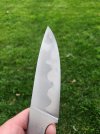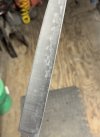K.B.,
Getting a hamon is like buying bananas. Some bananas will look different than others at the store. You don't know exactly what they will be like until you get them home and take them out of the peel. The length of ripening and how green they were when picked all change the final flavor and texture. You can go back tomorrow and the bananas may not taste the same. Every hamon is a combination of many factors. Getting the same result repeatedly is a long journey, and even after years of practice it usually has an unknown ending.
There are many different parameters that control a hamon. A short list of the biggest are:
Steel choice - low manganese and low alloy content.
Claying technique - not too thick, good grip on the blade, placement of the clay, ashi, etc.
quenchant - type, speed, temperature, time in quenchant
quench style - uninterrupted or interrupted.
Then you have the method of finishing that determines the final look:
Removal of any excess decarb - The unclayed exposed steel has a higher amount of decarb and many people think it is part of the hamon. Further sanding usually removes it.
Etchant - There are many types of etchants and different concentrations used to develop a hamon. You often have to try different ones to get a desired look. There is no one size fits all etchant. Some etchants are - mustard, lemon juice, vinegars, dilute FC, very dilute nitric acid.
Method of togi (finishing) - If you just grind the blade clean, sand it smooth, and dunk it in the FC tank you will get a very different hamon than doing a traditional togi or a hybrid-finish. The surfaces are worked down with belts by some and by hand only by others. Sanding can be with SC papers or hazuya and jizuya fingert stones. There are folks who use very fine soft die makers stones. Finishing polishes are usually metal oxides. A short list is -red iron oxide, black iron oxide, yellow iron oxide, green chromium oxide, white tin oxide, cerium oxide, fine silicon carbide powders, Linde A and B, ... and more.
NOTE:
Your hamon looks pretty good. I suspect that island at the tip is decarb. It is highly unlikely that the thinnest part would be unhardened. I would carefully hand sand it more to see if it starts to disappear.



